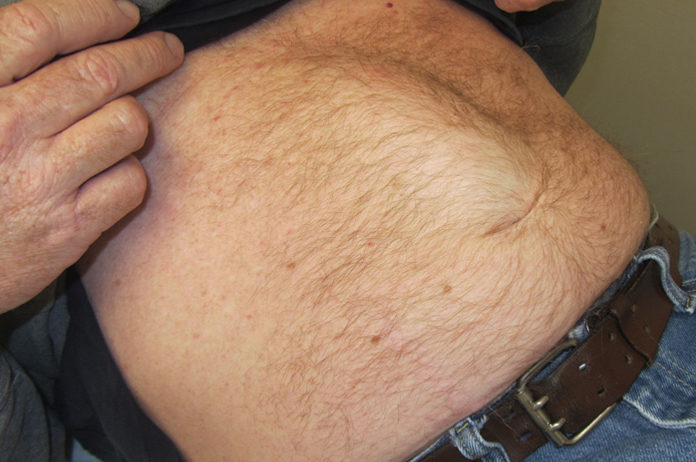Ever seen a woman looking pregnant even after she had her baby? Well, she might be suffering from diastasis recti. This is a condition wherein the muscles of the belly separate during the time of pregnancy.
It leaves a gap between the muscles and allows the belly to become protruding. The diastasis recti are not very serious but can lead to certain problems like urinary incontinence, pain in the lower back, pain while having sexual intercourse, constipation, and pain in the pelvic bone or hip.
It also makes women, and sometimes even men, look quite ugly. In fact, it is a common post-partum issue that women silently suffer from. Almost two-third part of pregnant women carries on with their lives with diastasis recti.
Remarkably, diastasis recti occur not only in women but also in overweight men and sometimes in infants.
What are Symptoms of diastasis recti?
Some of the diastasis recti symptoms include the following:
- A bump in the middle of the abdomen
- You will notice extra tissue in the frontal abdominal walls
- Pain in the lower back
- Constipation
- Problems in the pelvic floor
- A hernia is a possibility in which another organ can push through the abdominal wall
- Bloating
How to diagnose if you have diastasis recti?
If you keep an eye on your health, you can definitely notice the changes to your body after your baby’s birth. To further check for the problem, lie down and bending your knees. Your feet should be on the floor.
Put your palm on your belly in such a way that the fingers point towards the belly. Press the naval area with your fingers while lifting your head. As you move the chin towards the chest, your rectus abdomen will contract.
If there is a gap equivalent to the width of two fingers, then you have a diastasis. Follow the same procedure below the belly button. The separation might be different in different places.
What are causes of diastasis recti?
Diastasis recti are caused when extreme pressure is created in the inner abdomen. During pregnancy, the connective tissues and abdominal muscles are expanded because of the uterus. The expansion is facilitated by the release of the oestrogen and relaxin hormones.
Sometimes diastasis recti can happen during delivery when you are pushing the infant. Some amount of abdominal separation occurs when during the time of pregnancy and after it also. Sometimes premature
This usually happens because the abdominal muscles are connected yet not developed fully. But this heals by itself as the baby grows up.
How to do treatment of diastasis recti?
Abdominal separation is a common thing to happen to all women. Therefore, it is advisable to wear support while working during the day.
Diastasis recti usually weaken the core muscles of the back and the pelvic region. You will need to take care of yourself during pregnancy to avoid this condition as much as possible. Try the following:
- Do not lift heavy objects or strain the abdominal muscles while you are pregnant.
- Always sit in a good posture.
- Place a pillow or towel to offer support to the lower back muscles.
- While climbing in or out of the bed support yourself with the arm.
- Exercise even when you are pregnant to strengthen your core muscles.
For some women, the abdominal muscles heal and strengthen automatically following delivery. But for others, exercise is the way out. You can take the help of a physical therapist or a fitness expert.
The exercise set includes pelvic floor exercises and those for the deep muscles in the stomach. If the belly muscle separation is not too much, you can continue with it.
But it would help if you considered the options of how to fix diastasis recti before getting pregnant again. A doctor can tell how much the separation is with the help of
If the exercise fails, you can also consider operations like the tummy tuck or abdominoplasty. In this case, your surgeon will sew back the central ridge, which is weak. Laparoscopy is also an alternative.
What to avoid during diastasis recti?
Exercises are good for the stomach muscles, but if you have diastasis recti and the abdomen has not healed properly, you should avoid certain exercises because they can aggravate the condition.
- Traditional crunches
- Planks
- Sit-ups
- Swimming
- Certain yoga poses
- Working on your hands and knees
- Exercises where the belly muscles come out
- Holding the infant on one hip
- Lifting heavy things
- Constipation
- Coughing or sneezing without giving support to the belly muscles
Who can have it?
Diastasis recti usually happen to women who are petite and have given birth to more than one baby. It can also happen if you have had twins, triplets or more children at the same time. Women with improper posture and weak muscles are also likely to face this problem.
Alternately, if you had suffered from diastasis recti with your previous pregnancy, then you are likely to face it with the rest of them also. Those with a ventral or umbilical hernia and weak pelvis are more likely to develop the problem.
Do men face the same problem?
Diastasis recti in men are also pretty common with reasons and symptoms similar to women. There are specific diastasis recti exercises for men for those who choose to rectify the problem through exercise.
They can also try to get the diastasis recti operated on. There can be minor complications like hematoma and skin infection. Post-operative pain and nerve damage also take place at times.
Conclusion
It is impossible to say who will or will not develop this problem. And, for women, if you thought that just because it has been years since you had children, there is no way to get diastasis recti corrected, then you are mistaken.
The amount of time required for the separation to heal depends on your conviction to get rid of the situation. You will have to get hold of the right set of exercises for diastasis recti and perform them regularly to get into shape. It will, of course, take time and a huge amount of effort, but you can succeed if you try really hard.




